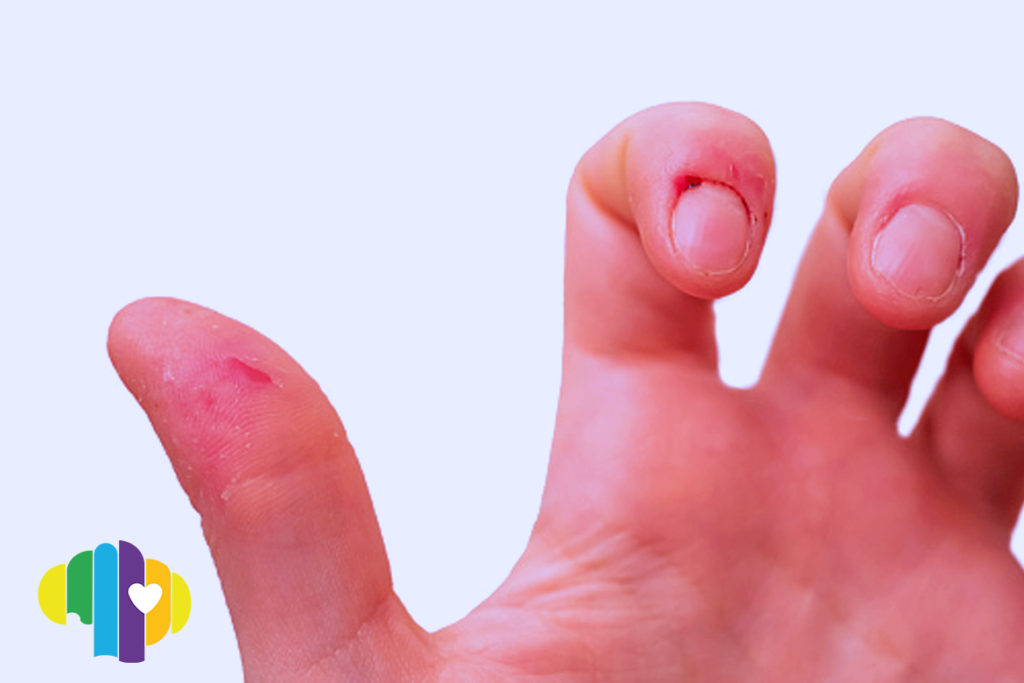Skin Picking Disorder, which is also known as dermatillomania and Excoriation Disorder, is commonly linked with Obsessive-Compulsive Disorder. Due to the compulsive similarities between the two. It is under the main heading of Obsessive-Compulsive and Related Disorders as a sub-category in both the International Classification of Diseases and the Diagnostic and Statistical Manual of Mental Disorders clinical classification manuals.
What is the difference between OCD and Skin Picking Disorder?
However, despite the fact that there are compulsive similarities between OCD and skin picking disorder, they are still not the same condition. They are not the same condition because there are also some significant differences.
In the Diagnostic and Statistical Manual of Mental Disorders, Skin Picking Disorder is listed in the ‘Obsessive Compulsive Disorder and Related Disorders’ category. Not within the Obsessive-Compulsive Disorder category itself.
Skin Picking Disorder is a body-focused repetitive behaviour similar to trichotillomania (hair-pulling disorder).
OCD, on the other hand, is an anxiety disorder, while skin picking is closer to an impulse control disorder. So while OCD and Skin Picking Disorder share some compulsive and ritualistic similarities between the two, they are also significantly different. OCD is driven by unwanted intrusive thoughts called obsessions. These obsessions are usually fears of bad things happening, so the person with OCD does some action in an attempt to prevent the bad thing from happening. The actions carried out to prevent the obsession are called compulsions. Unlike OCD, skin picking disorder is characterised by body-focused repetitive behaviour done on impulse to reduce tension/stress.
Symptoms
While everyone picks their skin from time to time. But for those with skin picking disorder, it is not every once in a while, but usually every day at the least. Some symptoms of it include:
- uncontrollably picking at your skin
- picking your skin so much that it can cause cuts, bleeding or bruising.
- Picking at moles, freckles, spots or scars in an attempt to “smooth” or “perfect” them
- not always realising that you are picking your skin or even doing it when you are sleeping
- picking your skin to reduce tension or stress when you feel anxious or stressed
Those with it may pick their skin in many different ways, like using their fingers, fingernails, tools like tweezers, pins or scissors or even their teeth.
The most common body areas that those with SPD pick are the face and arms. However, these individuals with SPD may also pick at skin irregularities such as moles, freckles, spots, or previous picking scars to ‘smooth’ them out or ‘perfect’ them. Most of these individuals will pick with their fingernails, but some may use tweezers or other objects like scissors.
People with skin picking disorder will often spend large amounts of time, sometimes several hours per day, on their picking compulsive rituals. These people may also have these skin picking issues that last for long periods, like in some cases, months or years. This large amount of time spent can cause distress and/or impairment, which can significantly hinder social interaction. Which would often be avoided if scars from the picking were visibly present.

Causes
Skin picking disorder is like obsessive-compulsive Disorder, as the person with OCD or Skin Picking Disorder cannot stop themselves from carrying out a particular action.
Skin Picking Disorder can be triggered by:
- anxiety or stress
- feelings like guilt, shame or any other negative emotions
- acne, eczema or other skin conditions
- Blemishes that the person wants to get rid of like spots, moles, scars and any other ‘blemish’. These blemishes may not be noticeable to other people.
- Boredom
Skin Picking Disorder is a body-focused repetitive behaviour and is similar to repetitive hair-pulling Disorder (trichotillomania).
It’s also similar to some obsessive-compulsive disorders that make the person obsessed with their appearance.
Treatments
Skin Picking Disorder is treated in a similar way to OCD. The treatment found to be most common and effective when treating it is a talking therapy called Cognitive Behavioural Therapy (CBT). During CBT a technique called habit reversal training may be used. This Technique works by helping you be more aware of your skin picking and its triggers.
Habit reversal training helps you by replacing harmful behaviour (skin picking) with less harmful behaviour. During the therapy treatment, some people find they also need the additional support of anti-depressant medications to help them. This medication will usually be a form of anti-depressant Selective Serotonin Re-uptake Inhibitor medications.
Suppose this treatment (therapy) is offered. In that case, community mental health services will usually provide it. If the patient needs medication, the GP or a specialist like a psychiatrist will prescribe it.
Tips for those With Skin Picking Disorder
If you have Skin Picking Disorder, you should contact your GP and seek treatment. But as the treatment will not help you instantly get better, you should learn some tips and tricks to help you live with it more comfortably and safely.
Some things you can do to help yourself live with it include:
- keeping your hands busy with other less harmful activities like squeezing a ball
- Try to identify what triggers you to pick your skin and avoid them as much as possible.
- Try to resist the urge to pick your skin for longer and longer each time.
- When you get the urge to pick your skincare for it instead like, for example, by moisturizing it using moisturizer.
- Tell people around you, so they can help you identify when you’re picking
- avoid infection by keeping your skin clean
Some things you should not do when living with it include:
- letting your nails grow long as if they get too long, they can do more damage to your skin if you pick
- keeping things like pins, scissors or tweezers where you can easily use them as you will then use these objects to damage your skin
When should you contact your GP?
As everyone picks their skin from time to time, those with Skin Picking Disorder can pick their skin without noticing or realising. It can be hard to know when you have it and need to see a GP.
You need to see a GP if:
- you are unable to stop picking your skin
- serious damage to your skin s caused by you picking it, like injuries that do not heal within a few days
- you’re emotionally distressed, or your life is being affected due to you picking your skin



